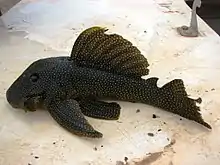Baryancistrus
Baryancistrus is a genus of freshwater Loricariid catfish. They inhabit flowing sections of rivers, especially clearwater, in the basins of the Amazon (notably Trombetas, Tapajós, Xingu and Tocantins) and Orinoco (notably Ventuari) in Brazil and Venezuela. The largest species reach up to 34 cm (13 in) in total length.[1]
| Baryancistrus | |
|---|---|
 | |
| Baryancistrus niveatus | |
| Scientific classification | |
| Domain: | Eukaryota |
| Kingdom: | Animalia |
| Phylum: | Chordata |
| Class: | Actinopterygii |
| Order: | Siluriformes |
| Family: | Loricariidae |
| Tribe: | Ancistrini |
| Genus: | Baryancistrus Rapp Py-Daniel, 1989 |
| Type species | |
| Hypostomus niveatus Castelnau, 1855 | |
Most Baryancistrus are differentiated from other related genera by a membrane connecting their dorsal fin and adipose fin, not present in most other genera.[2]
The species of this genus are mainly herbivores and detritivores, but may take other foods in an aquarium setting. Most have probably not been bred in captivity. It is difficult to sex these fish, including adult specimens. These fish are mainly nocturnal, but will also emerge from their hiding places during the day, after some time getting accustomed to the aquarium. Adequate hiding places are recommended for these fish due to their primary nocturnal nature.
Species
There are currently eight recognized species in this genus:[1][3]
- Baryancistrus beggini Lujan, Arce H. & Armbruster, 2009 (Blue panaque)
- Baryancistrus chrysolomus Rapp Py-Daniel, Zuanon & R. R. de Oliveira, 2011
- Baryancistrus demantoides Werneke, Sabaj Pérez, Lujan & Armbruster, 2005
- Baryancistrus hadrostomus de Oliveira, Rapp Py-Daniel & Oyakawa, 2019
- Baryancistrus longipinnis (Kindle, 1895)
- Baryancistrus micropunctatus de Oliveira, Rapp Py-Daniel & Oyakawa, 2019
- Baryancistrus niveatus (Castelnau, 1855)
- Baryancistrus xanthellus Rapp Py-Daniel, Zuanon & R. R. de Oliveira, 2011 (Golden nugget pleco)
List of Baryancistrus sp. L-numbers
Though there are many types of fish described as Baryancistrus, there are many that yet to be given a true scientific designation, and are only referred to under the L-number system, including the Gold Nuggets. Here is a list of Baryancistrus by L-number designation. The common name and scientific name are included when available, though some of these fish are only commonly referred to by their L-number. For those fish without a scientific name, they are assumed to be Baryancistrus sp.
| L-number(s) or LDA | Common name(s) | Scientific name |
|---|---|---|
| L003 | Kieser pleco | |
| L018, L085 | Gold Nugget pleco | Baryancistrus xanthellus |
| L019 | ||
| L026 | Baryancistrus niveatus | |
| L047 | Magnum pleco, Mango pleco | Baryancistrus chrysolomus |
| L057 | ||
| L081 | Gold Nugget pleco | Baryancistrus xanthellus |
| L084 | ||
| L115, L248 | Mega snowball pleco | |
| L142, LDA33 | Big White Spot pleco | |
| L177 | Iriri Gold Nugget pleco | Baryancistrus xanthellus |
| L200* | Baryancistrus demantoides | |
| L219 | ||
| L274 | ||
| L239 | Blue Panaque | Baryancistrus beggini |
| L319 | ||
| L323 | ||
| L324 | ||
| L364 | ||
| L384 | ||
| LDA60 | gold nugget | Baryancistrus xanthellus |
* Note: L200 is also used to refer to Hemiancistrus subviridis, another Loricariid that is very similar in appearance to B. demantoides.
References
- Froese, Rainer and Pauly, Daniel, eds. (2017). Species of Baryancistrus in FishBase. October 2017 version.
- Werneke, David C.; Sabaj, Mark H.; Lujan, Nathan K.; Armbruster, Jonathan W. (2005). "Baryancistrus demantoides and Hemiancistrus subviridis, two new uniquely colored species of catfishes from Venezuela (Siluriformes: Loricariidae)" (PDF). Neotropical Ichthyology. Sociedade Brasileira de Ictiologia. 3 (4): 533–542. doi:10.1590/S1679-62252005000400011. Archived from the original (PDF) on 2007-06-30.
- Oliveira, Renildo Ribeiro de; Py-Daniel, Lúcia Rapp; Oyakawa, Osvaldo Takeshi (2019-09-12). "Two New Species of the Armored Catfish Genus Baryancistrus Rapp Py-Daniel, 1989 (Siluriformes: Loricariidae) from Jari River, Amazon Basin, Brazil". Copeia. 107 (3): 481–492. doi:10.1643/CI-19-201. ISSN 0045-8511.
![]() Media related to Baryancistrus at Wikimedia Commons
Media related to Baryancistrus at Wikimedia Commons